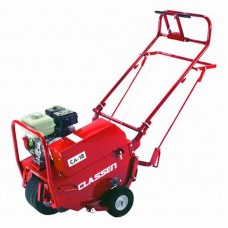Pulls out a 2" plug. 18" wide path. Self-propelled. 5.5 hp gas Honda engine. Recommended when renting the aerator to have either a pick up truck or trailer for transporting. Can estimate same amount of time as it would take to mow your lawn with a 21" mower.
What Is Aeration?
Technically speaking, aeration is the naturally occurring process of air exchange between the soil and its surrounding atmosphere. Practically speaking, aeration is the process of mechanically removing small plugs of thatch and soil from the lawn to improve natural soil aeration. It's commonly called core aeration in the lawn service industry, and you may have heard of it as soil cultivation (coring, spiking and slicing). Most homeowners simply call it aeration.
Aeration Benefits:
Core aeration can help make your lawn healthier and reduce its maintenance requirements through these means:
Bullet Improved air exchange between the soil and atmosphere.
Bullet Enhanced soil water uptake.
Bullet Improved fertilizer uptake and use.
Bullet Reduced water runoff and puddling.
Bullet Stronger turf grass roots.
Bullet Reduced soil compaction.
Bullet Enhanced heat and drought stress tolerance.
Bullet Improved resiliency and cushioning.
Bullet Enhanced thatch breakdown.
Aeration Equipment Affects the Outcome...
The type of aeration equipment can determine how effective the treatment will be. In general, turf responds best when core holes are close and deep. Equipment with hollow tines removes soil cores. Equipment with open tines divots the soil surface. Aeration equipment also varies in tine size up to
3/4 inch diameter and in depth of penetration up to 4 inches, depending on the manufacturer's specifications.
How Often Should You Aerate a Lawn?
Most lawns benefit from annual aeration. Heavily used lawns, or those growing on heavy clay or sub-soils may need more than one aeration each year. Again, turf responds best when tine spacing is closer and penetration is deeper.
When is the Best Time to Aerate Lawns?
If you have cool season turf grass such as Kentucky bluegrass and perennial rye grass, both spring and fall are ideal times to aerate. In spring, aerate between March and May. Perform fall aeration between August and November. Aeration before or at the time of late season fertilization enhances root growth and improves spring green-up and growth. Warm season turf grasses such as zoysia grass and Bermuda grass should be aerated in mid-spring to summer. Avoid aerating when warm season grasses are dormant, it may encourage weed competition. In addition, avoid aerating warm season grasses during spring cleanup, and not until after their first spring mowing.
View Deposit Information
Pricing
$49.00 - 2 Hour Rate
$21.00 - Each Additional Hour
$105.00 - Daily Rate
$351.00 - Weekly Rate
- WEIGHT - 278 LBS WITH WEIGHTS, 202 WITHOUT
- WIDTH - 27.75"
- HEIGHT - 48.5"
- LENGTH - 53"
- AERATING WIDTH - 17.5"
- PRODUCTION - 23,000 SQR FT PER HOUR
LAWN AERATOR
- Product Code:2-4620-4104
- Availability:In Stock
-
View Deposit Information
Pricing
$49.00 - 2 Hour Rate
$21.00 - Each Additional Hour
$105.00 - Daily Rate
$351.00 - Weekly Rate Documentation 
Common mistakes when renting power aerator.pdf
Power aerator operator's manual.pdf
What is Damage Waiver.pdf
Tags: aerator power, lawn aerator, grass aerator, sod aerator,



